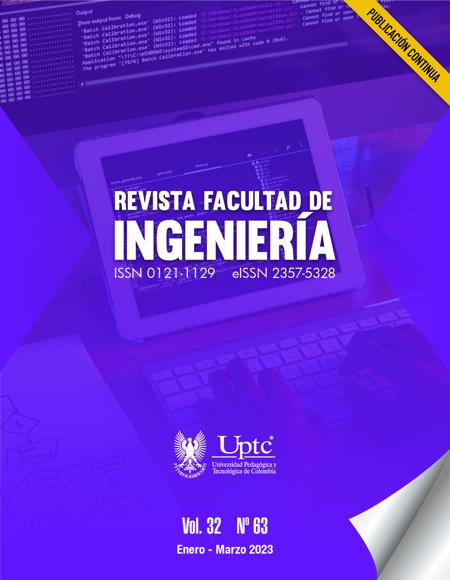IoT-LAT: Prototipo de gemelo digital para la simulación de escenarios educativos de los laboratorios de arte y tecnología del Instituto Departamental de Bellas Artes, Cali, Colombia

Resumen
Los Gemelos Digitales (DT) tienen el potencial de transformar procesos de manufactura, construcción, mantenimiento y control de diferentes procesos industriales debido a que permiten la integración entre el mundo físico y el mundo digital. Sin embargo, el diseño y desarrollo de conceptos digitales complejos requiere que sus metodologías y procesos se implementen correctamente. En este trabajo se presenta el desarrollo de un prototipo de gemelo digital de los laboratorios de arte y tecnología del Instituto Departamental de Bellas Artes, Cali, utilizando el proceso de desarrollo ágil Scrum, el cual facilitó la organización en el diseño y desarrollo del prototipo IoT-LAT. Para la construcción se estableció una arquitectura IOT de 3 capas que permitió mapear los componentes del gemelo digital y los elementos reales a simular para su construcción. El prototipo IoT-LAT permite a estudiantes y docentes interactuar e informarse digitalmente del estado físico del laboratorio, conocer cuáles elementos tecnológicos se encuentran disponibles en el espacio y cómo se usan.
Palabras clave
Gemelo digital, Internet de las cosas, Metodologías agiles, Simulación virtual, Scrum
Citas
- D. J. Wagg, P. Gardner, R. J. Barthorpe, W. K., “Digital Twins: State-of-The-Art and Future Directions for Modeling and Simulation in Engineering Dynamics Applications,” Journal of Risk and Uncertainty in Engineering Systems, Part B: Mechanical Engineering, vol. 6, no. 3, e4046739, 2020. https://doi.org/10.1115/1.4046739 DOI: https://doi.org/10.1115/1.4046739
- M. Singh, E. Fuenmayor, E. P. Hinchy, Y. Qiao, N. Murray, D. Devine, “Digital Twin: Origin to future,” Applied System Innovation, vol. 4, no. 36, e4020036, 2021. https://doi.org/10.3390/asi4020036 DOI: https://doi.org/10.3390/asi4020036
- M. Grieves, Origins of the Digital Twin Concept. 2016. Working paper. https://doi.org/10.13140/RG.2.2.26367.61609
- A. El Saddik, “Digital twins: The convergence of multimedia technologies,” IEEE multimedia, vol. 25, no. 2, pp. 87–92, 2018. https://doi.org/10.1109/MMUL.2018.023121167 DOI: https://doi.org/10.1109/MMUL.2018.023121167
- Y. Fu, G. Zhu, M. Zh, F. Xuan, “Digital Twin for Integration of Design-Manufacturing-Maintenance: An Overview,” Chinese Journal of Mechanical Engineering, vol. 35, no. 80, e760, 2022. https://doi.org/10.1186/s10033-022-00760-x DOI: https://doi.org/10.1186/s10033-022-00760-x
- F. Tao, J. Cheng, Q. Qi, M. Zhang, H. Zhang, F. Sui, “Digital twin-driven product design, manufacturing and service with big data,” The International Journal of Advanced Manufacturing Technology, vol. 94, no. 9, pp. 3563–3576, 2017. https://doi.org/10.1007/S00170-017-0233-1 DOI: https://doi.org/10.1007/s00170-017-0233-1
- A. Sharma, E. Kosasih, J. Zhang, A. Brintrup, A. Calinescu, “Digital Twins: State of the art theory and practice, challenges, and open research questions,” Journal of Industrial Information Integration, vol. 30, e100383, 2022. https://doi.org/10.1016/j.jii.2022.100383 DOI: https://doi.org/10.1016/j.jii.2022.100383
- A. M. Madni, D. Erwin, A. Madni, “Exploiting Digital Twin Technology to Teach Engineering Fundamentals and Afford Real-World Learning Opportunities,” in ASEE Annual Conference & Exposition, 2019. https://doi.org/10.18260/1-2--32800 DOI: https://doi.org/10.18260/1-2--32800
- T. I. Erdei, R. Krakó, G. Husi, “Design of a Digital Twin Training Centre for an Industrial Robot Arm,” Applied Sciences (Switzerland), vol. 12, e8862, 2022. https://doi.org/10.3390/app12178862 DOI: https://doi.org/10.3390/app12178862
- Y.-B. Lin, M.-Z. Shieh, M.-F. Shih, C.-C. Cheng, “EduTalk: An IoT Environment for Learning Computer Programming and Physics,” IEEE Internet Things Journal, vol. 9, no. 21, pp. 21946–21957, 2022. https://doi.org/10.1109/JIOT.2022.3182280 DOI: https://doi.org/10.1109/JIOT.2022.3182280
- K. A. Peppler, “Media arts: Arts education for a digital age,” Teachers College Record, vol. 112, no. 8, pp. 2118–2153, 2010. https://doi.org/10.1177/016146811011200806 DOI: https://doi.org/10.1177/016146811011200806
- M. Xiong, H. Wang, “Digital twin applications in aviation industry: A review,” The International Journal of Advanced Manufacturing Technology 2022, vol. 121, no. 9, pp. 5677–5692, 2022. https://doi.org/10.1007/S00170-022-09717-9 DOI: https://doi.org/10.1007/s00170-022-09717-9
- H. T. Nguyen, Ø. Haugen, “Building Experimental Laboratory for Digital Twin in Service Oriented Architecture,” in Proceedings - 2022 IEEE 5th International Conference on Industrial Cyber-Physical Systems, ICPS 2022, pp.01-06 2022. https://doi.org/10.1109/ICPS51978.2022.9816926 DOI: https://doi.org/10.1109/ICPS51978.2022.9816926
- Bellas Artes Institución Universitaria del Valle, “Bellas Artes Institución Universitaria del Valle,” 2022. https://bellasartes.edu.co/
- K. Schwaber, J. Sutherland, “La guía scrum 2020(Scrum Guide 2020),” Scrum.org.
- L. Atzori, A. Iera, G. Morabito, “The Internet of Things: A survey,” Computer Networks, vol. 54, no. 15, pp. 2787–2805, 2010. https://doi.org/10.1016/j.comnet.2010.05.010 DOI: https://doi.org/10.1016/j.comnet.2010.05.010
- R. van Kranenburg, “The Internet of Things: A critique of ambient technology and the all-seeing network of RFID,” Institute of Network Cultures, 2007. https://acortar.link/uoJpXn
- S. Naveen, S. G. Hegde, “Study of IoT: Understanding IoT Architecture, Applications, Issues and Challenges,” in Proceedings - International Conference on Innovations in Computing & Networking, ICICN16. 2016.
- P. Gokhale, O. Bhat, S. Bhat, “Introduction to IOT,” International Advanced Research Journal in Science, Engineering and Technology, vol. 5, no. 1, pp. 41-46, 2018, https://doi.org/10.17148/IARJSET.2018.517
- J. Gubbi, R. Buyya, S. Marusic, and M. Palaniswami, “Internet of Things (IoT): A vision, architectural elements, and future directions,” Future Generation Computer Systems, vol. 29, no. 7, pp. 1645–1660, 2013. https://doi.org/10.1016/j.future.2013.01.010 DOI: https://doi.org/10.1016/j.future.2013.01.010
- J. Zhang, M. Liang, “A new architecture for converged internet of things,” in International Conference on Internet Technology and Applications, ITAP 2010, pp. 1-4, 2010. https://doi.org/10.1109/ITAPP.2010.5566263 DOI: https://doi.org/10.1109/ITAPP.2010.5566263
- O. Said, M. Masud, “Towards Internet of Things: Survey and Future Vision,” International Journal of Computer Networks, vol. 5, no. 1, e001, 2013.
- D. Dinculeană, X. Cheng, “Vulnerabilities and Limitations of MQTT Protocol Used between IoT Devices,” Applied Sciences, vol. 9, no. 5, e848, 2019, https://doi.org/10.3390/APP9050848 DOI: https://doi.org/10.3390/app9050848
- Anonym, Sci-Fi Styled Modular Pack, 2022. https://assetstore.unity.com/packages/3d/environments/sci-fi/sci-fi-styled-modular-pack-82913
- D. Svanæs, A. Scharvet Lyngby, M. Bärnhold, T. Røsand, S. Subramanian, “UNITY-Things: An Internet-of-Things Software Framework Integrating Arduino-Enabled Remote Devices with the UNITY Game Engine,” Lecture Notes in Computer Science, vol. 12789, pp. 378–388, 2021. https://doi.org/10.1007/978-3-030-77277-2_29/COVER DOI: https://doi.org/10.1007/978-3-030-77277-2_29